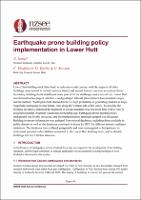Earthquake prone building policy implementation in Lower Hutt

Download
Date
2020-04-22Authors
Ismail, Najif
Hoddinott, Chris
Kerite, Derek
Stevens, Claire
Metadata
Show full item recordAbstract
Lower Hutt building stock dates back to early nineteenth century, with the majority of older buildings concentrated in central business district and around historic precincts in Jackson Street. Inevitably, buildings built at different times pose different challenges and levels of risk. Lower Hutt was focused in this project, which is a wedge-shaped alluvial plain between two mountain ranges and the harbour. Wellington fault, deemed to have a high probability of generating medium to large magnitude earthquake in near future, runs along the western side of the valley. To describe the building inventory, historical development in design standards was discussed first, with a view to associate potential structural weaknesses to building age. Earthquake prone building policy background was briefly discussed, and the implementation approach adopted was discussed. Building inventory information was gathered from several databases, including those available in public domain as well as the databases developed in-house by HCC for different seismic resilience initiatives. The databases were collated geospatially and were interrogated to find patterns, to understand potential vulnerabilities associated to the Lower Hutt building stock, and to identify buildings that merit further attention.
